West Bay Woodturners Newsletter is a monthly update on the club activities. This free resource is available to beginner and professional woodturners.
Next Meeting
Wednesday October 16,
7 pm at Bridges Church,
625 Magdalena Ave,
Los Altos 94024
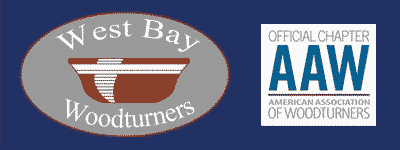
Program
Have you mastered the scraper? How many different scrapers do you have? Dave Vannier will cover different scrapers, why and how he uses them. If time permits, he will throw in a short demo of the bottom feeder.
President’s challenge:
Turn a pen! Yes you can! You might not have all the fancy jigs and tools required, but here’s an opportunity to connect with a fellow turner, visit someone’s shop, and practice the steps Jerry showed us last month. Maybe the few members that signed up for Pen for Troops can host other members to participate? Feel free to invite each other on Slack or email! It’s an opportunity for cooperation!
Upcoming Meetings and Demos
- October 16 meeting: David Vannier – The exciting world of Scrapers!
- November 20 meeting: Tom Gaston – So you wanted a handle on that bowl?
- December Holiday Party — details to follow
President’s Message
Well, who would have thought! Unheard of and surprising! After only a little bit (!) of arm twisting and cajoling, we have nominations for treasurer and president for the next board of directors. That is both a relief and exciting, and I can retire leaving the board in good hands. The nominations will be announced at next week’s meeting, so I’ll keep you guessing for now… And there is still time to nominate someone else, and maybe hold actual elections, although I expect that by Nov 20th our election won’t be as exiting as the “other one”! Thank you to those who are stepping forward, and as members of WBW the new board will need your continued support to runs our activities and programs. I can say from experience that it feels quite rewarding to see things happen from the inside, and be a part of it!
Claude Godcharles
Last Meeting Review
Wednesday September 18, 2024
Woodturners newsletter notes by Laura Rhodes, pictures by Angela Gunn and Roman Chernikov
Announcements
- Guests – Ken from coastside and Luanna from the Palo Alto Adult School
- Reminder about the sale at Glenn Krueg’s shop, Saturday, 9/21/2024 in Newark
- Oneway lathe is already soldStubby lathe still available
- Lots of wood
- Eric Lofstrom Demo
- Sunday, October 6, 10am-5pm at Maker Nexus, $30. Embellishments, bowls, hollow forms
- Eric will be available for private lessons on Saturday afternoon (10/5) and Monday morning (10/7). $100/hour. If interested, signup and Jerry Galli will facilitate
- Tom Gaston took a safety survey to see how many have had pieces come off the lathe? How many have been hit?
- Claude Godcharles spoke about the club Board of Directors elections coming up.
- Nominations in October, voting in November
- New board takes effect in January.
- Open positions: President and Treasurer
- Current President, Claude, went over key responsibilities
September Program: Pen Turning by Jerry Galli
Jerry is in his 4th year coordinating the Pens for the Troops program. This program has been run since 1994. Woodcraft provides the pen kits and the turned pens are turned in prior to Veteran’s Day for distribution to our U. S. service members. Last year, SVW donated 460 pens to the program.
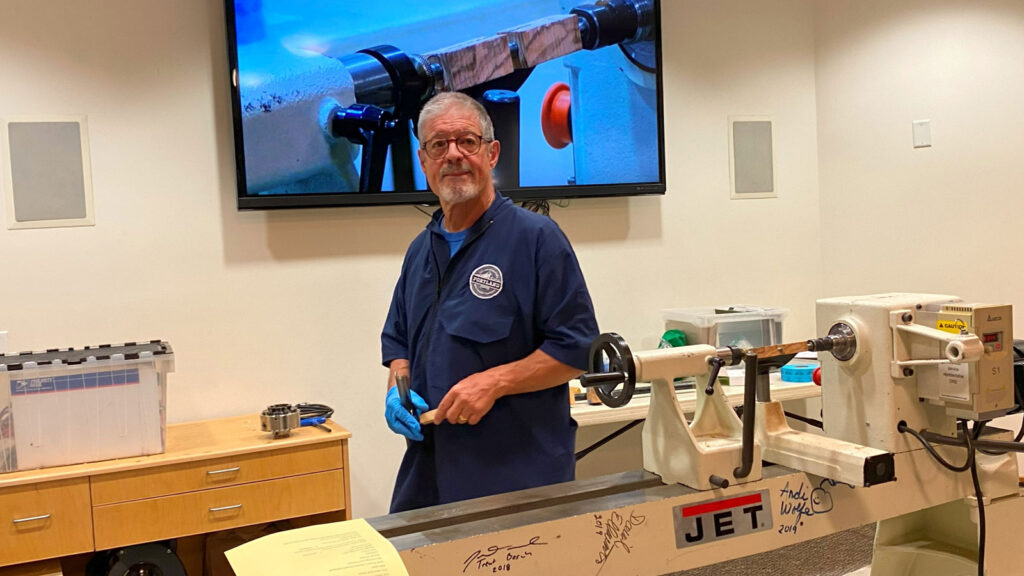
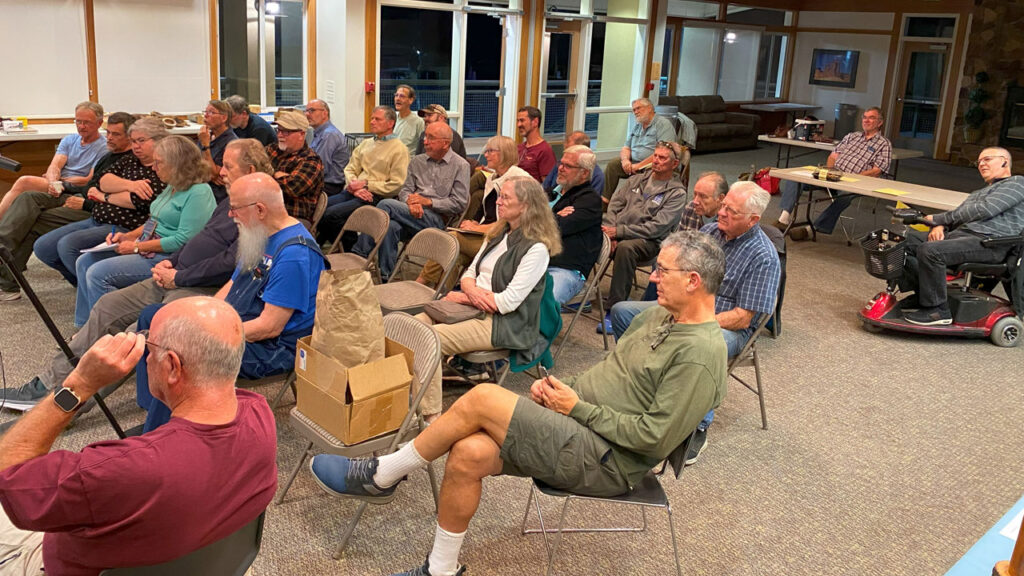
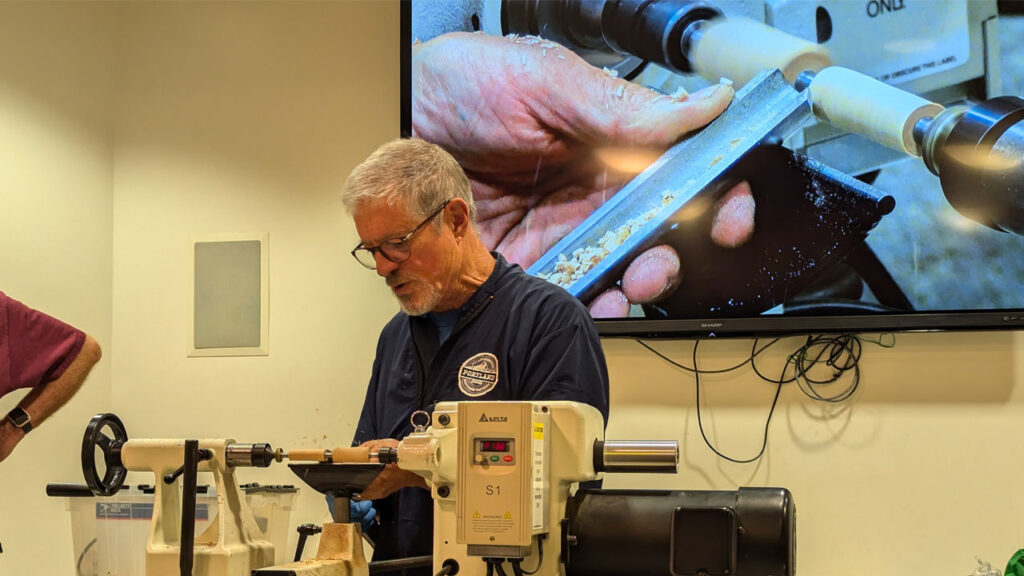
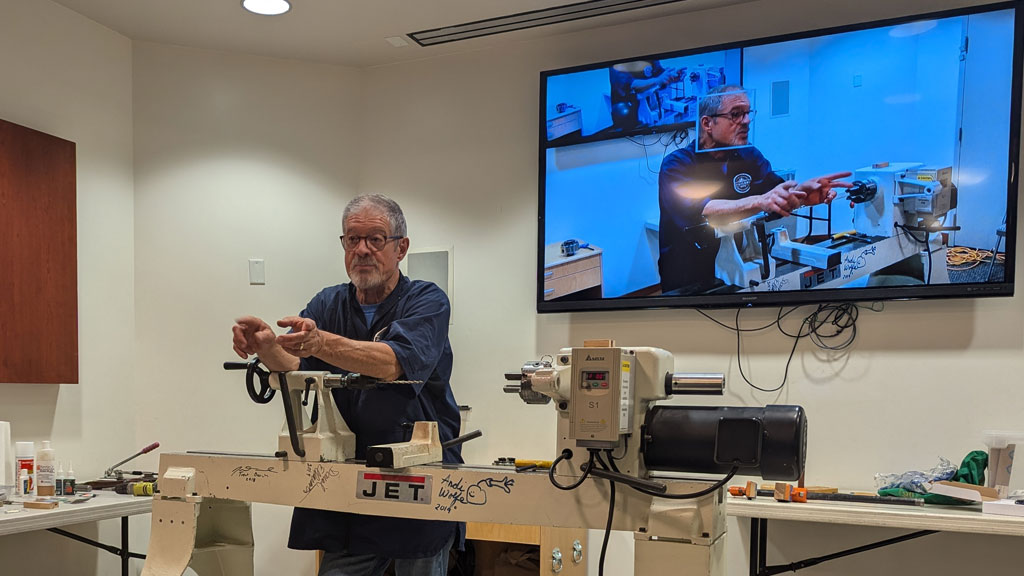
Jerry demonstrated his process for making a pen.
- Start with a wood pen blank, ¾” x ¾” x 5”.
- Mark along the center of the wood and then cut in half. (The mark will help to properly align the pen parts.)
- Holding each half in a set of pen jaws, using a Jacob’s chuck in the tail stock and the lathe at ~650rpm, drill a hole all the way through. For a slimline pen, use a 7mm drill bit.
- Jerry recommends an adjustable-type pen mandrel, as well as the use of a pen mandrel saver.
- Put the tubes from the kit on the mandrel and abrade with 180 and 240 grit.
- Use medium CA glue to glue the tubes into the two pen blanks.
- Use a pen reamer to level the ends of the pen blank with the tubes.
- Using bushings appropriate for the selected pen kit, put the pen blank pieces onto the mandrel. Use the original markings to align the parts.
- Use a roughing gouge turn the pen to the desired form, sizing the ends of each piece with the bounding bushings.
- Sand the pen with the lathe running (up to at least 600 grit, or for best finish, up to 12000 grit using micro mesh). Sand with the grain (after the 600 grit) without the lathe running.
- Clean off the pen with a paper towel.
- Apply 2 coats of thin CA glue and 3 coats of Doctor’s Pen Plus friction polish.
- Press the pen parts together using a dedicated pen press. Other options include: making or buying Morse taper between centers pen press; using a pipe clamp.
Presidents Challenge: Not a Bowl
Let see how diverse our turning craft can be!
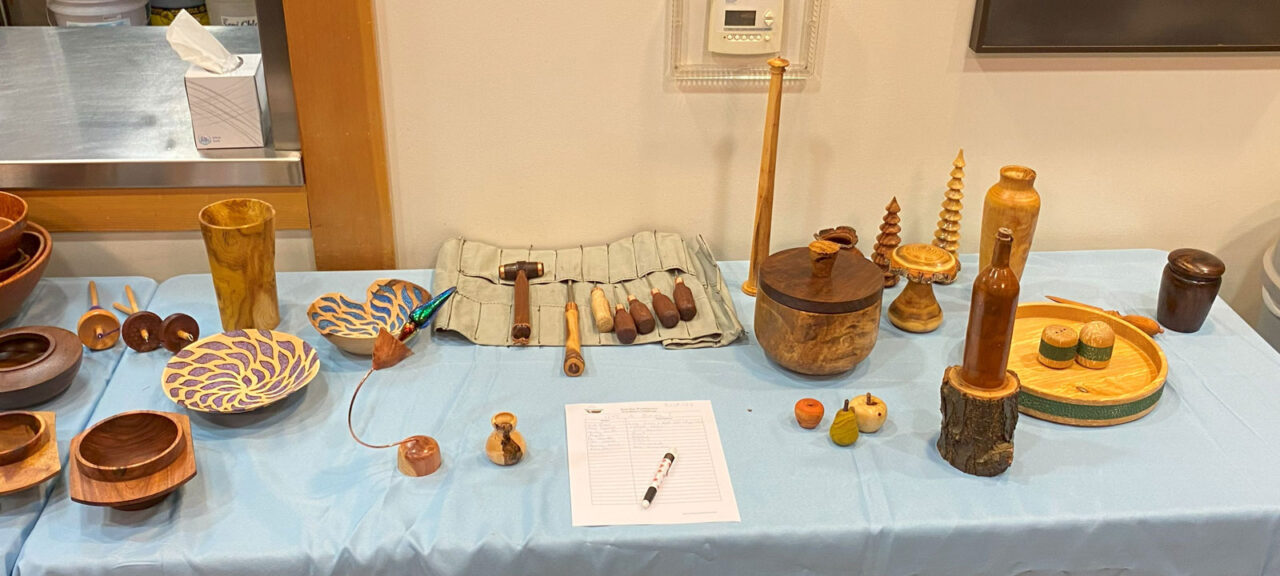
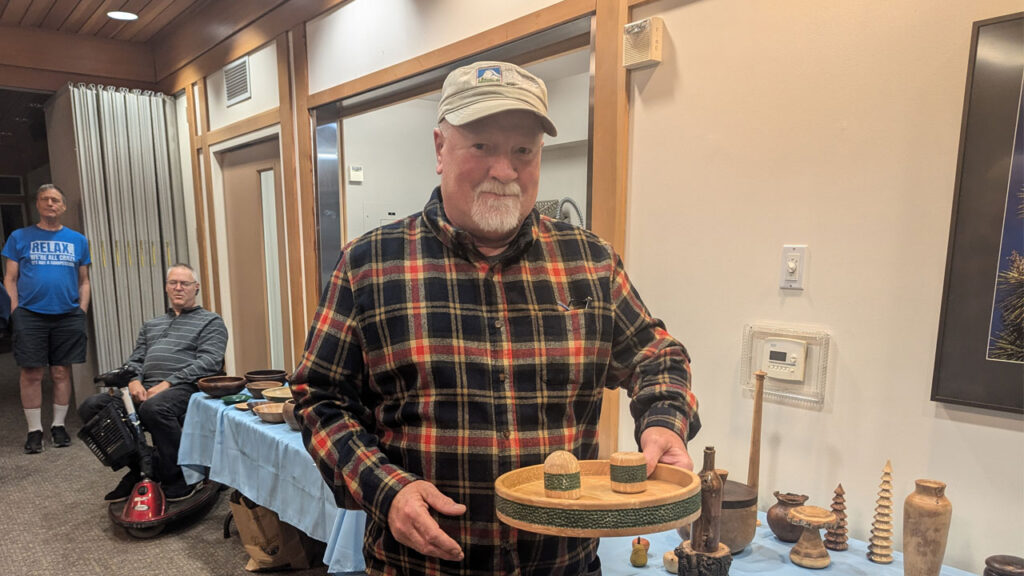
Jim Koren had cutoffs from a spalted red alder table he made. From these, he made a lazy susan, and salt and pepper shakers. He embellished the items with Dremel pit “dimpling” and milk paint.
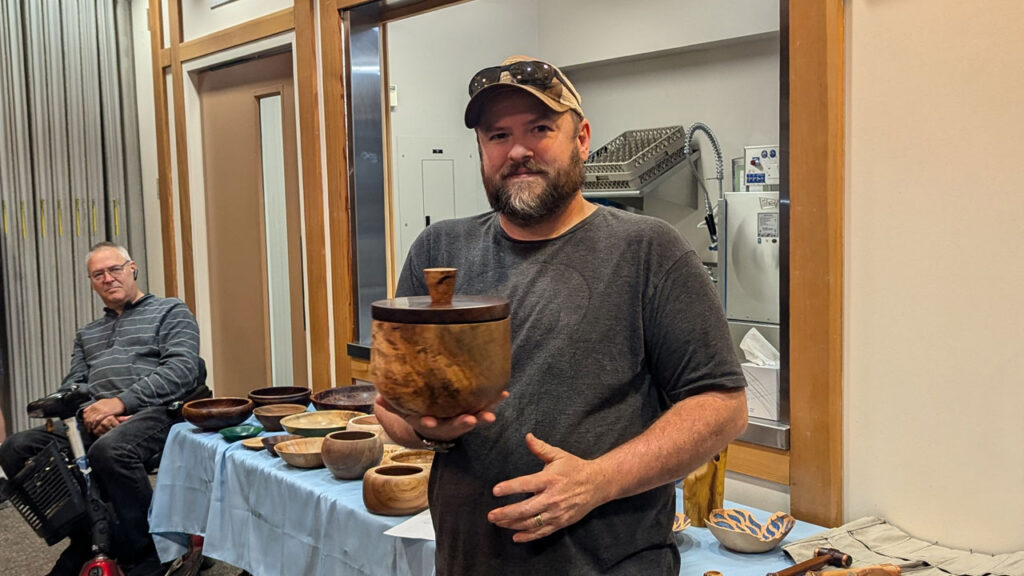
Nate Seagraves made a lidded vessel with a figured silver maple base from a neighbor’s tree, a curly walnut top, and maple burl knob.
Kelly Smith had a whole collection of “not-a-bowls” to share including a lighthouse, an apricot vase, a locust mushroom, an olive tree, a poplar tree, and a letter opener.
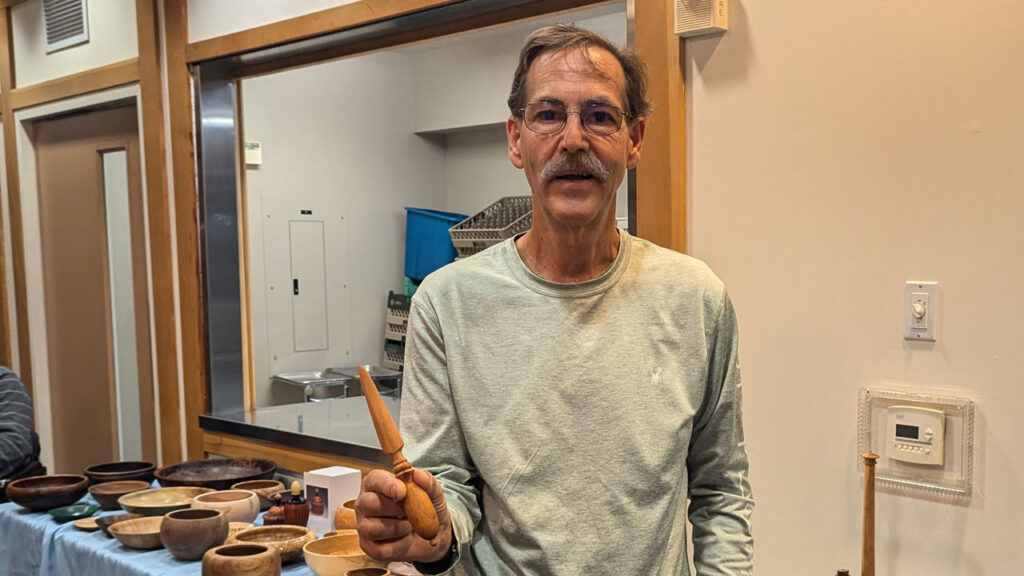
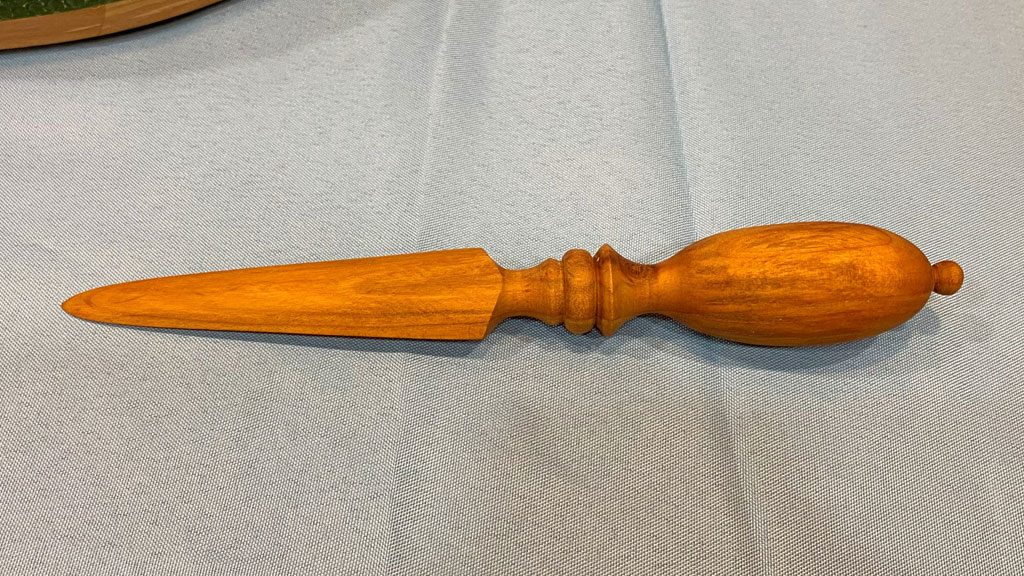
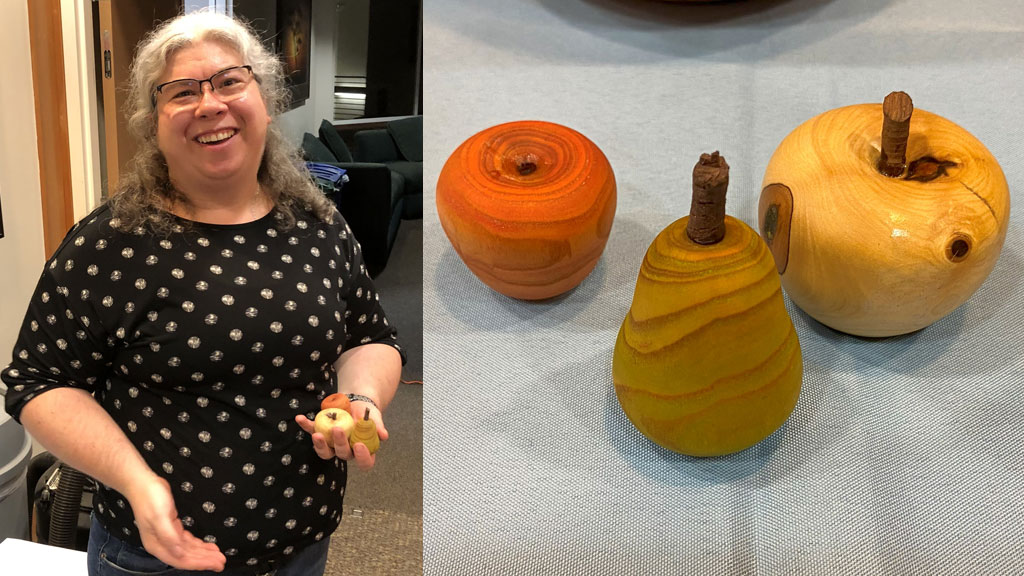
Angela Gunn shared a pear and two apples, painted with acrylic paint. These were portions of her contributions to the WIT (Women-in-Turning) Virtual Exchange project. As part of this program, she and her partners (one from Colorado and one from Maryland) were given the noun/modifier prompt, “Generosity/Relaxed”, and decided to make a Lazy Susan Zen garden.
Tom Gaston showed a set of home-made tools with turned handles and copper pipe ferrules. The tools included a plane hammer, a beading tool, and a small chisel.
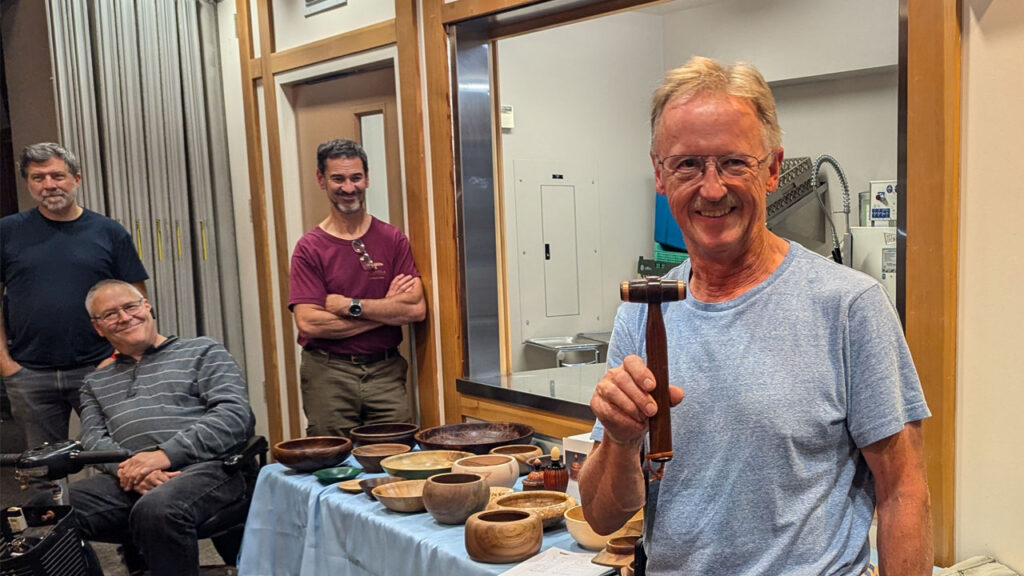
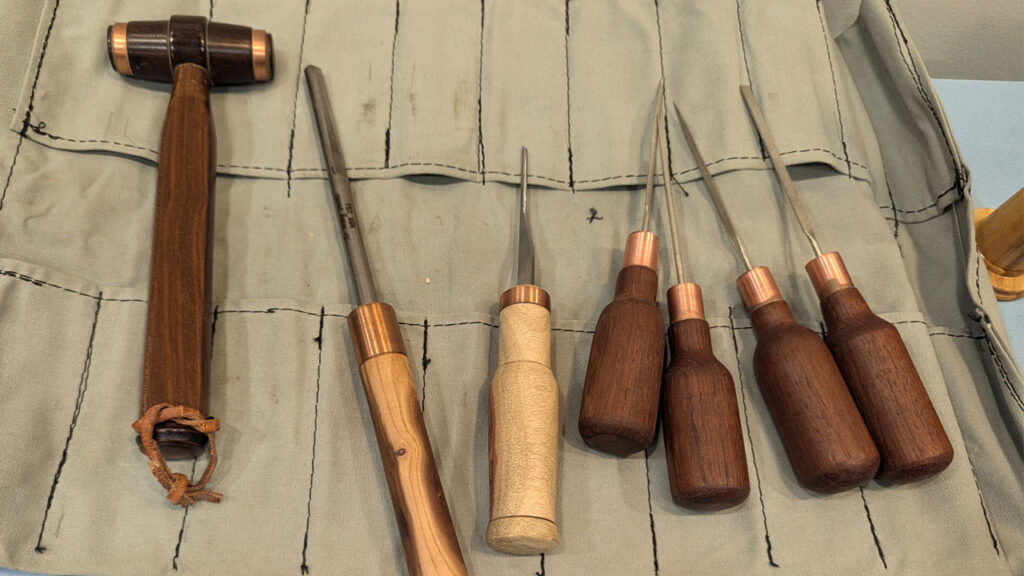
Harvey Klein made a flower with hummingbird out of juniper, inspired by UK turner, Colwin Way. He painted the bird black and then gave it iridescent colors using Emma Cook’s mica flakes.
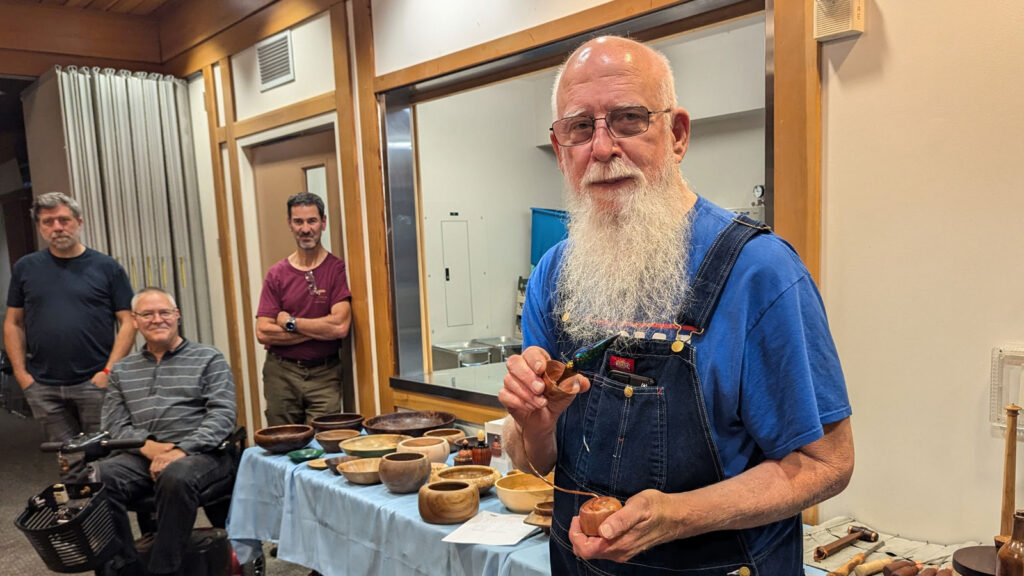
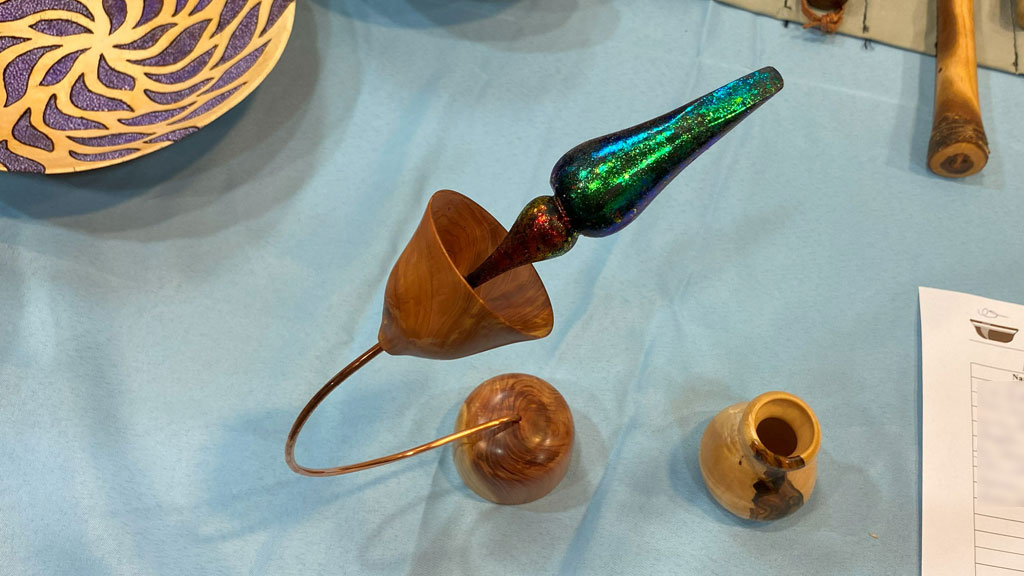
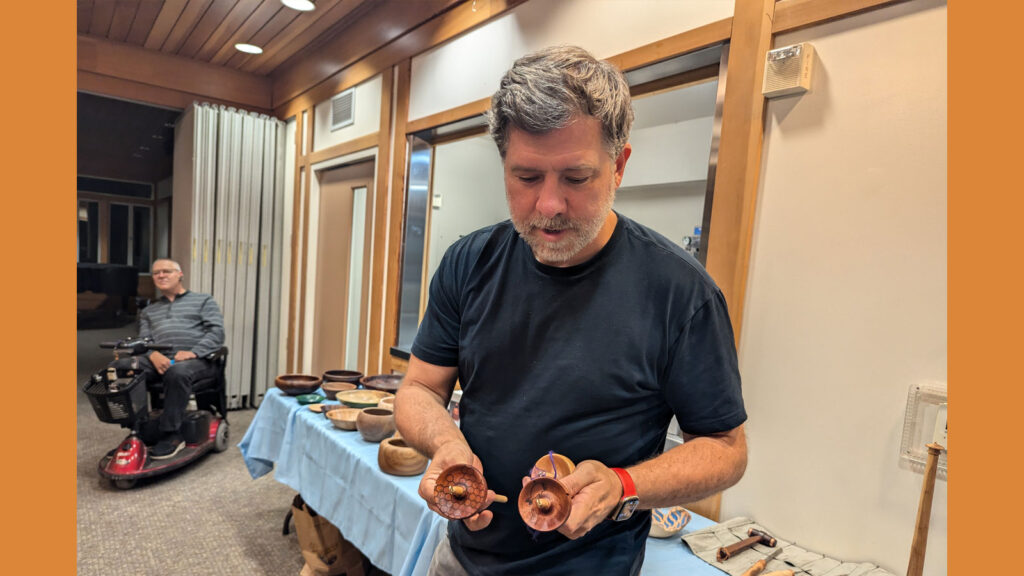
James Craig showed drop spindles (used for hand-spinning yarn) that he made for his daughter and son. He laser etched the spindles to customize them for each child.
Show & Tell:

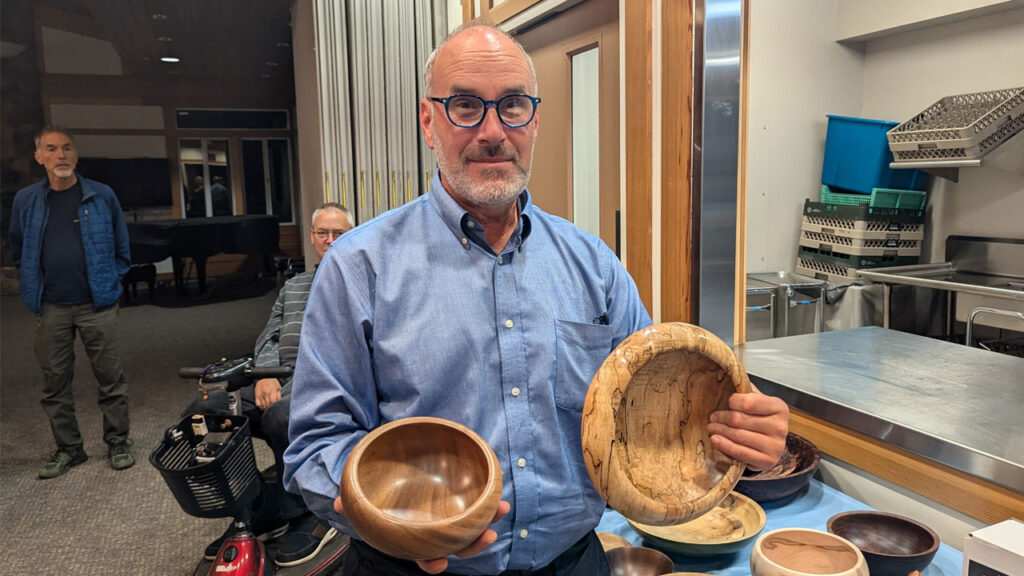
Daniel Saal showed several closed-form bowls. Two from walnut, one from a mystery wood and one from ambrosia maple.
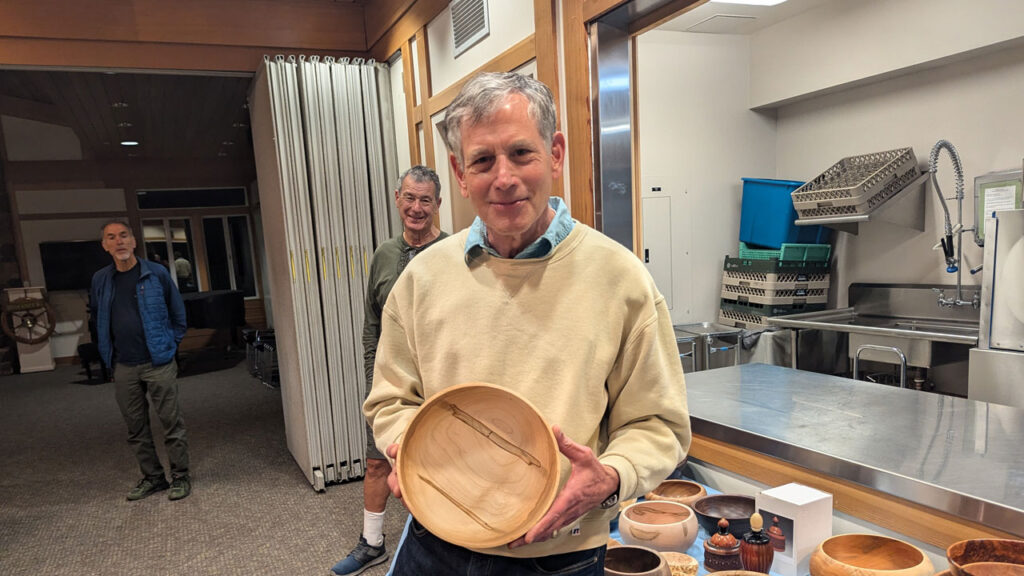
Tom Mandle made several bowls, one from Chinese elm, one from ambrosia maple, one from walnut. He had some issues with out-of-date finish (shellac and Tried & True) which gummed up his sandpaper.
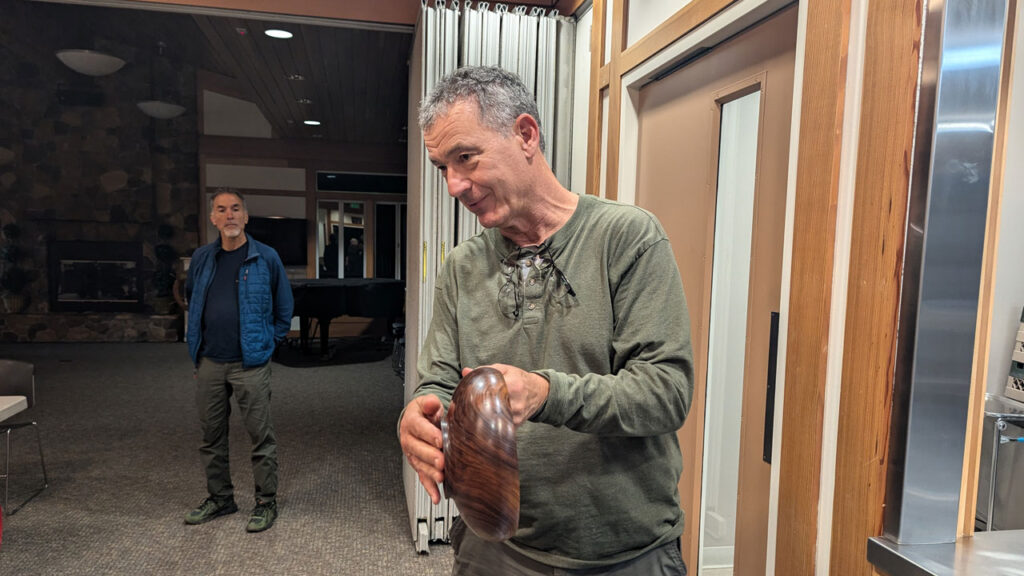
Jon Bishop brought two bowls made of black acacia, finished with Tried & True, and buffed. He aimed for a continuous curve extending under the foot. He had a bowl of Bay Laurel with red and green milk paint topped with shellac and poly.
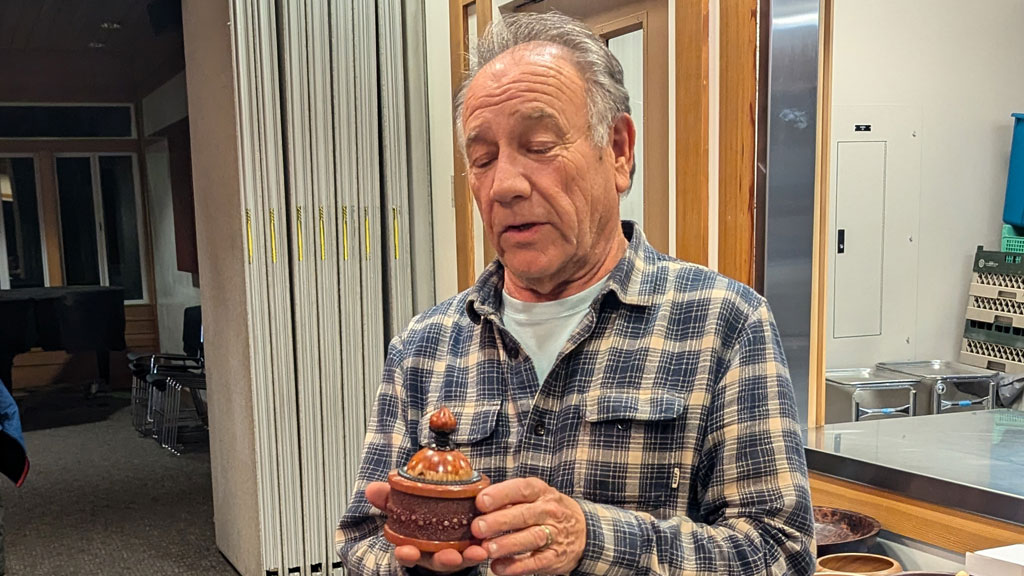
Jon Sauer showed an intricate box of mopani, African Blackwood, Amboyna burl surrounded by shagreen. This box required several different steps and mountings and is the result of about 20 hours of work.
Visit Jon’s website: https://www.jonsauer.com/
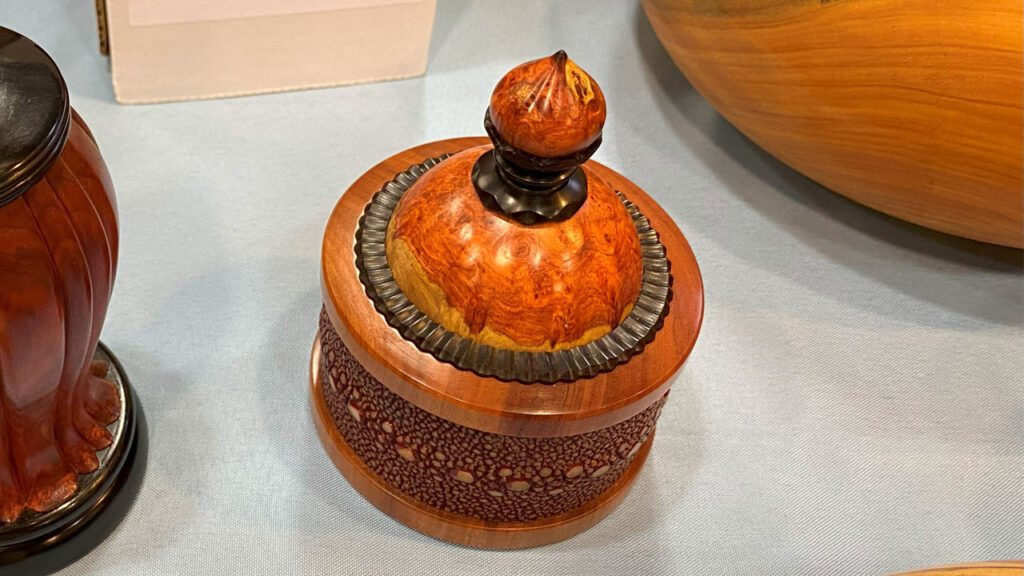
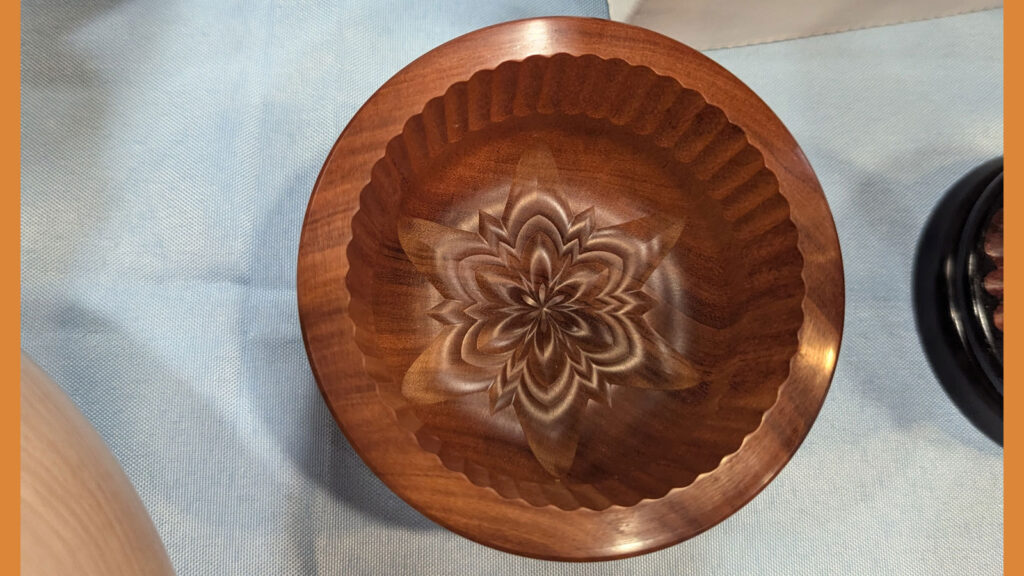
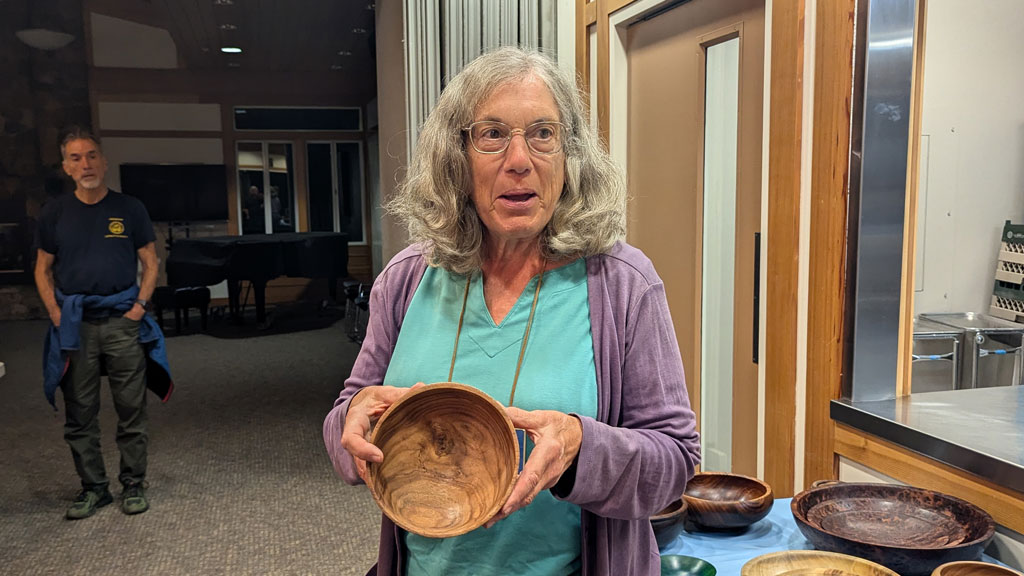
Laura Rhodes made a bowl of walnut from what was an unassuming blank but turned into one of the most beautiful bowls she has made.
Al Holstein made an off-center bowl from a maple burl. To mount the bowl on the lathe, he glued on a waste block.
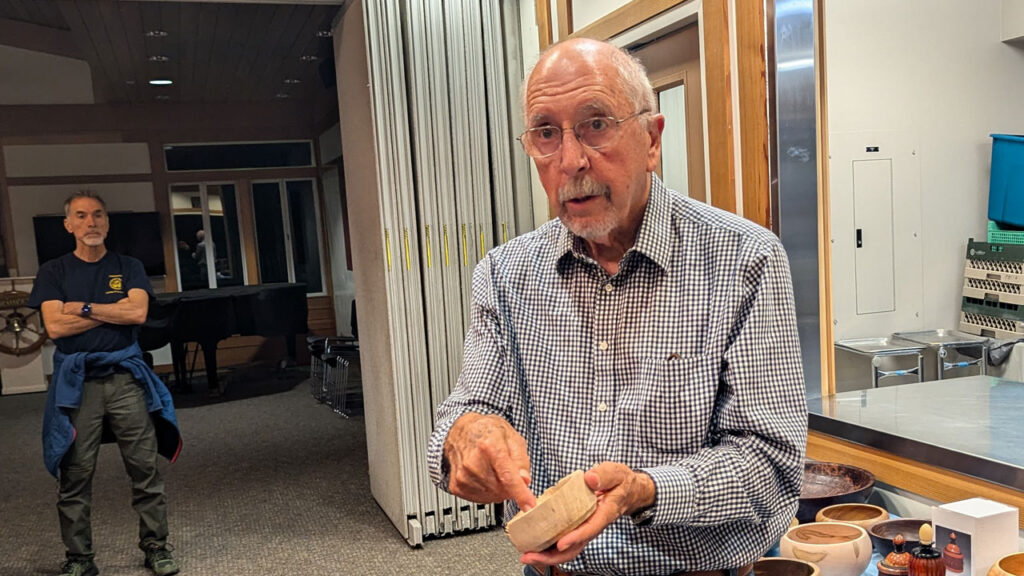
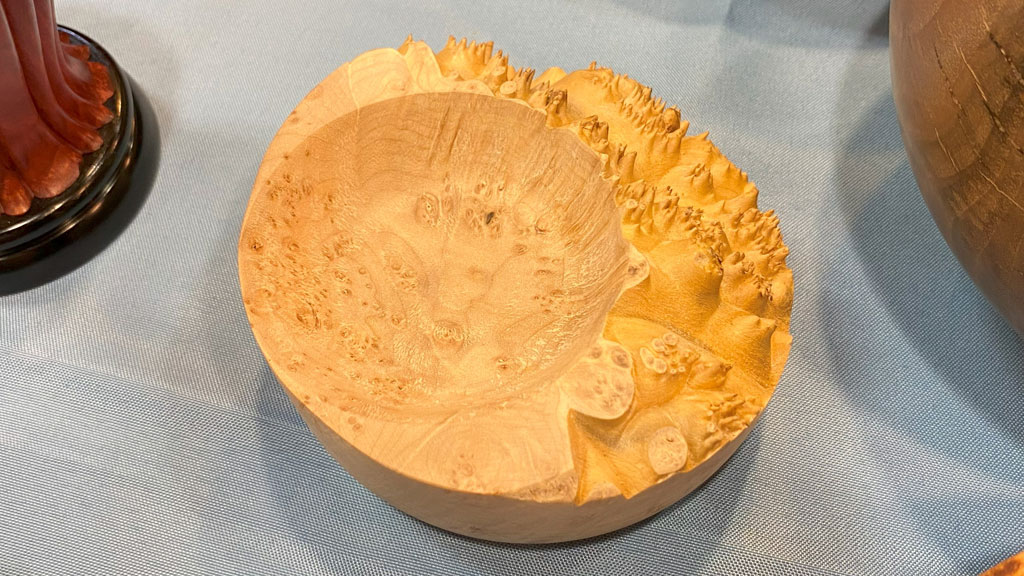
Dave Vannier played the CTC game – “Chase the Crack”. He started with a 14” maple bowl and its core, but both bowls ended up being similar in size. He embellished these bowls with techniques learned from Donna Zils Banfield at the Portland AAW Symposium. Both inside and outside of the bowls had woodburned shapes that were textured and then painted (one hand-painted, the other airbrushed). Visit Dave’s website: www.daves-turned-art.com
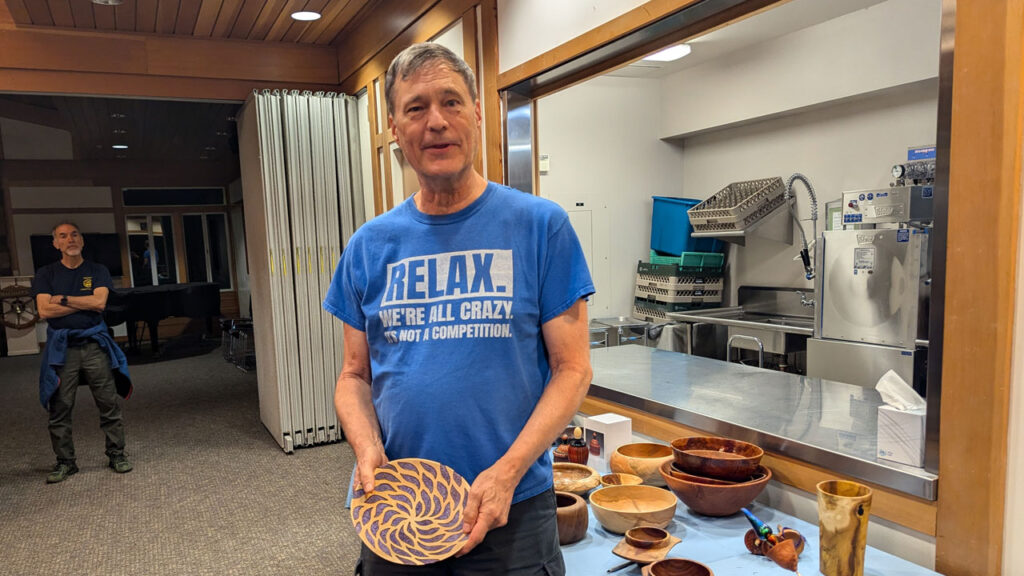
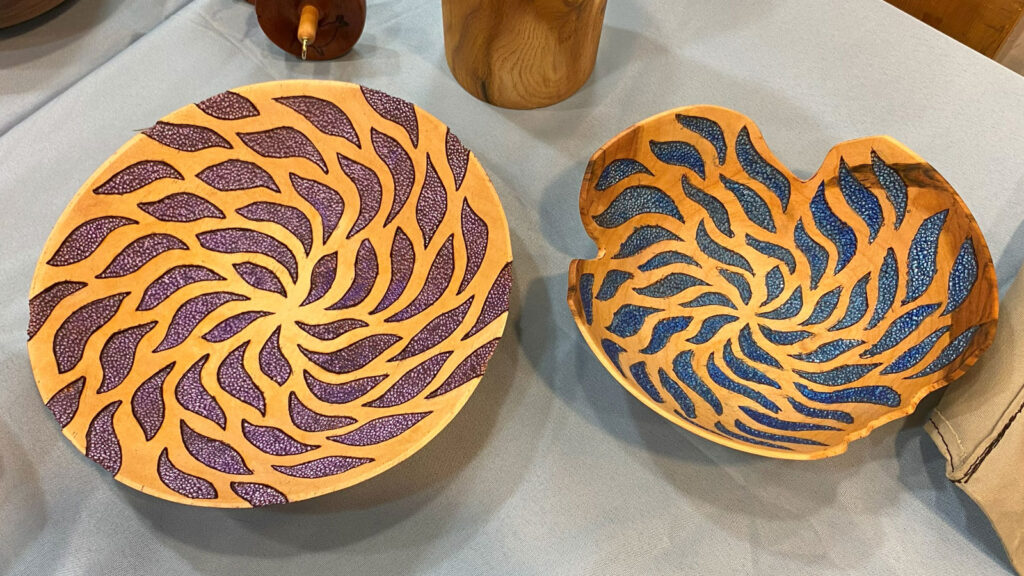
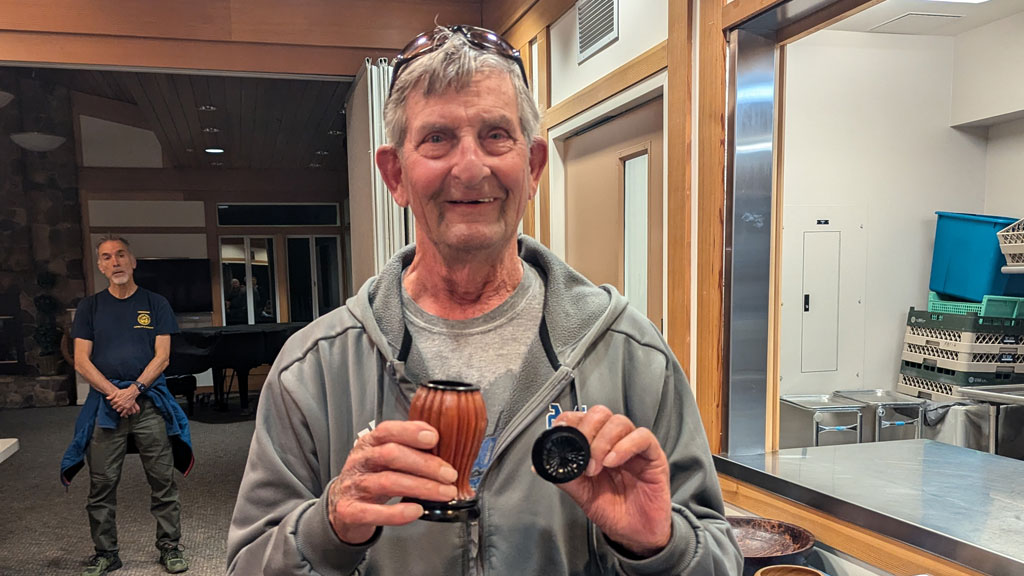
Dale Bassman made a lidded box using his rose engine from red heart, African Blackwood and Tagua nut.
Nate Seagraves showed a core set of old growth redwood burl he acquired using Craig’s list. He cored the bowls on Dave V.’s lathe using Dave’s coring system. It was the first time Nate had turned in someone else’s shop. He finished the bowls with walnut oil.
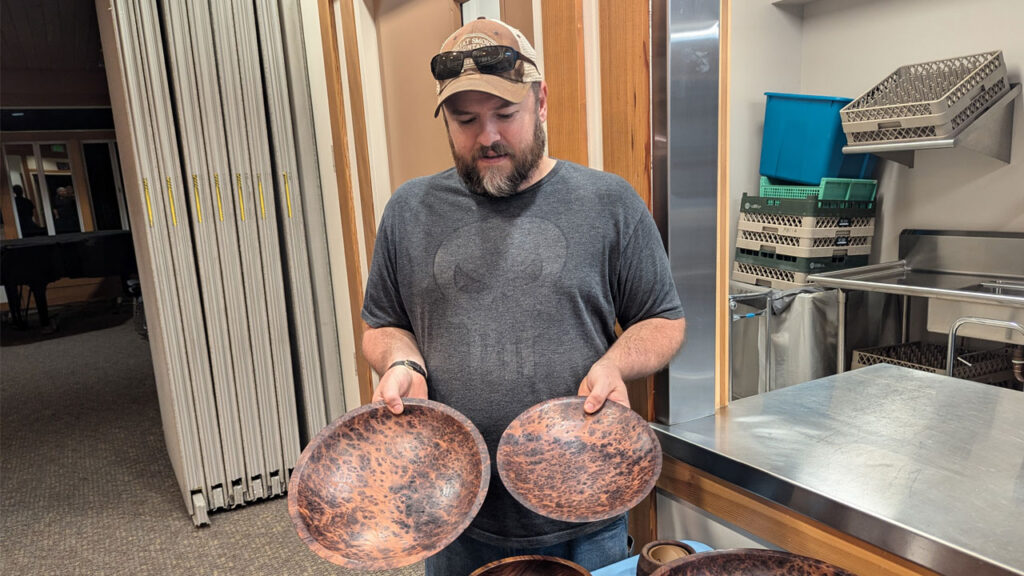
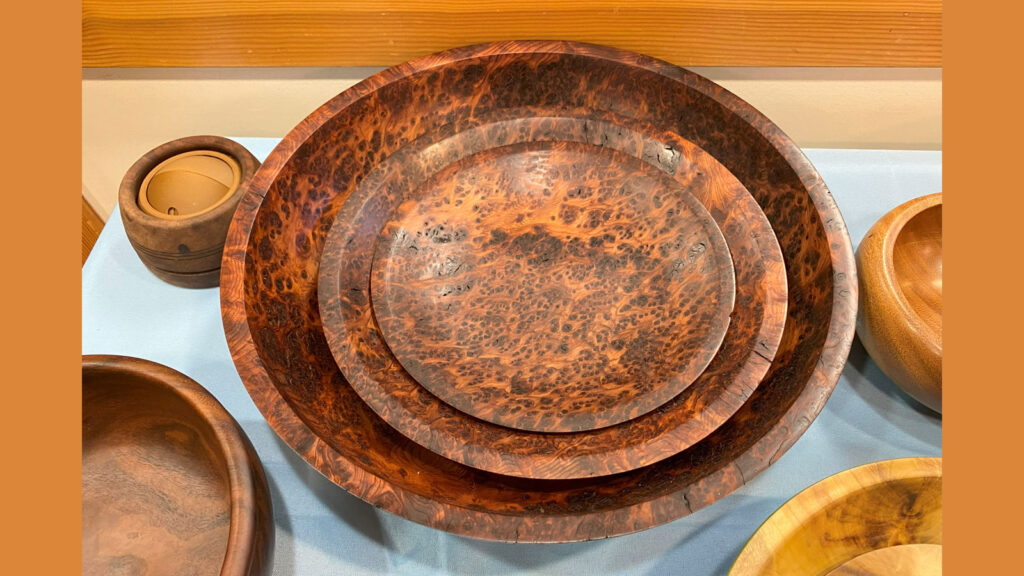
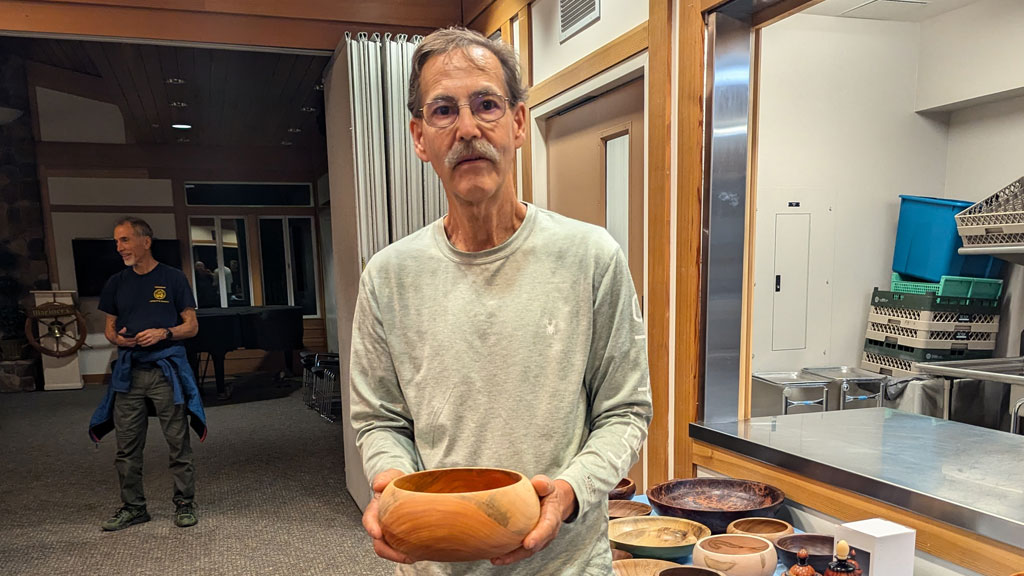
Kelly Smith made a collection of bowls: one from olive with the figure forming two lions, one of cedar from his front yard, two from madrone, one from walnut, one from apricot, one from cherry. He also had a calabash bowl that started off as a pumpkin shape, but the top was inadvertently truncated.
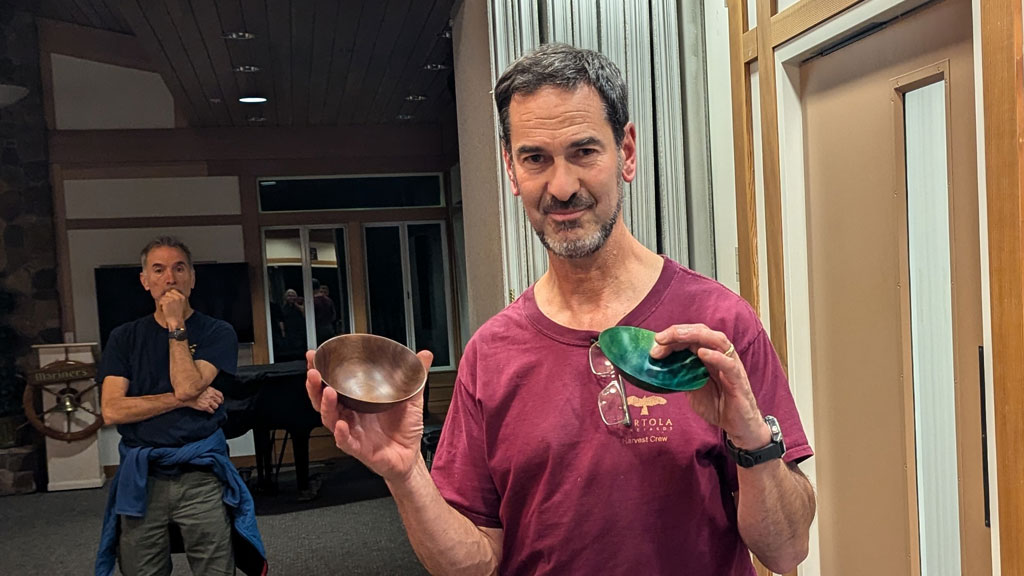
Chip Krausekopf made thin bowls of camphor, walnut and oak. He experimented with dyes but had issues when using the vacuum chuck pulled the dye from the outside into the inside.
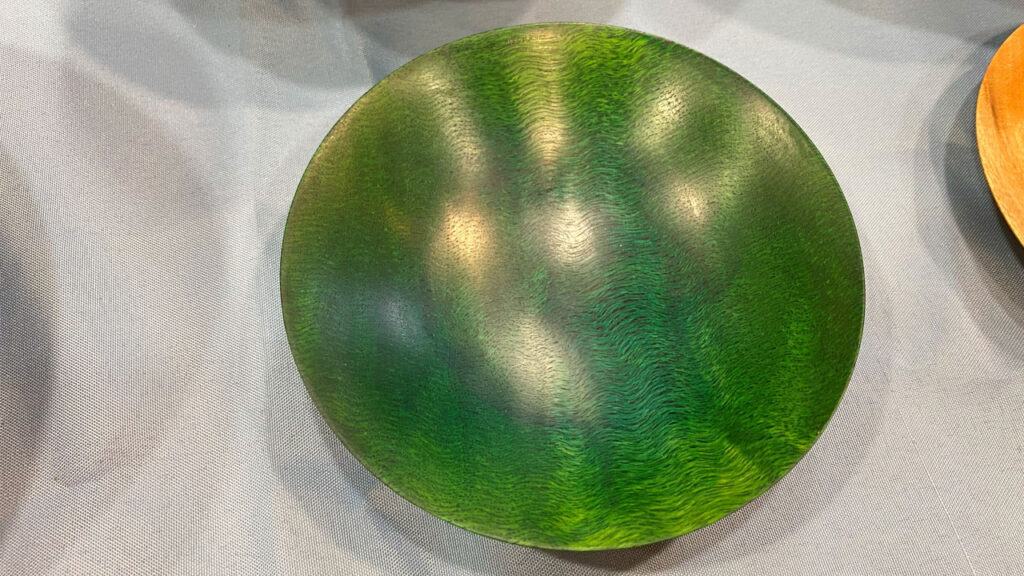
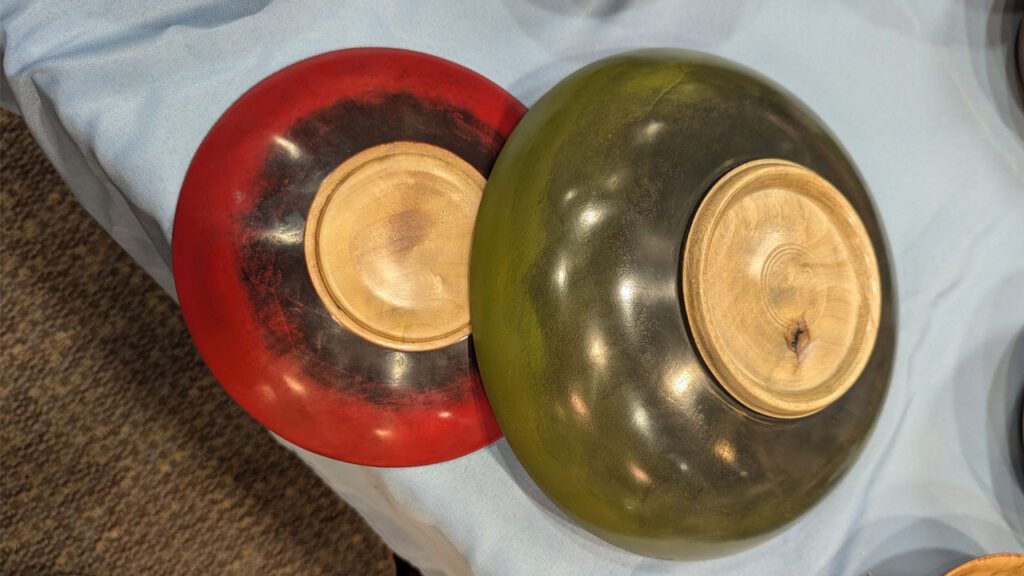
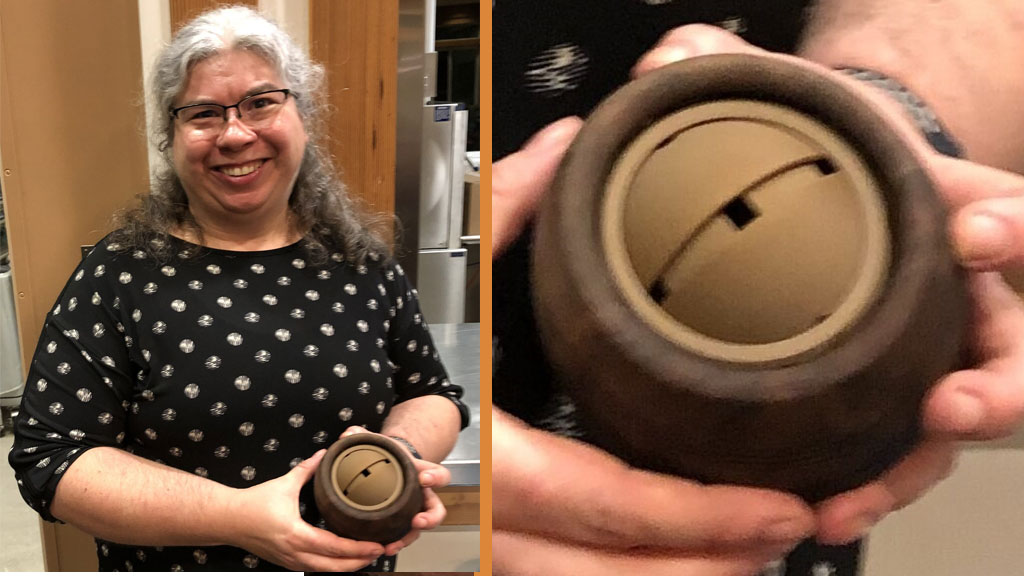
Angela Gunn collaborated with her husband on a box with a turned form and a 3D-printed wood filament iris-shutter mechanism opening.
Participation Prizes
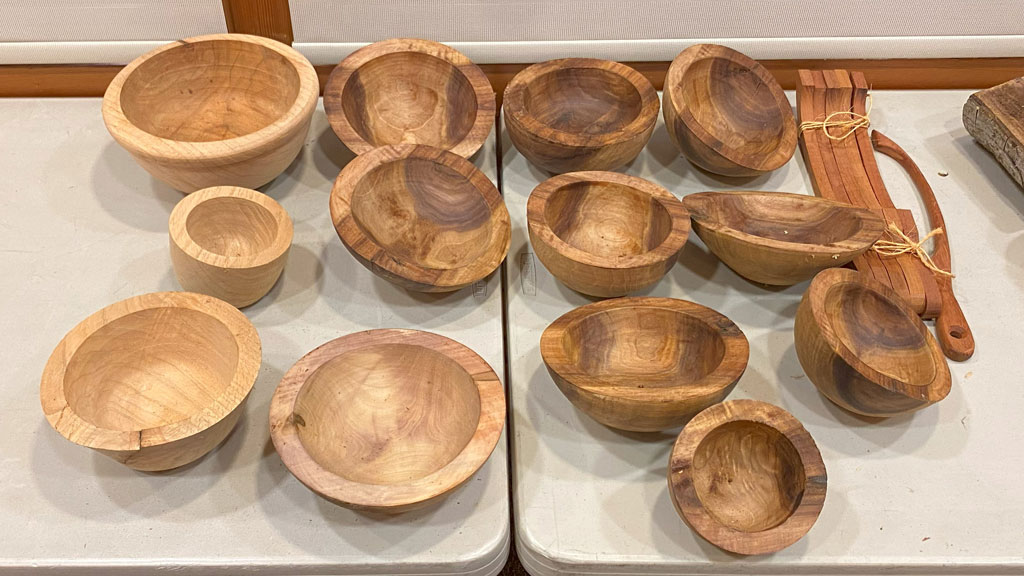
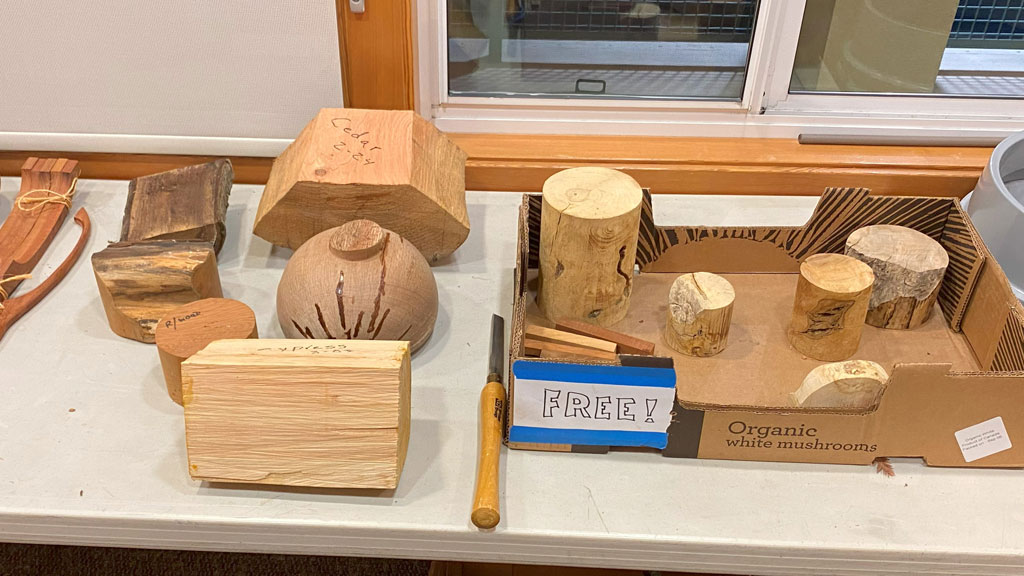
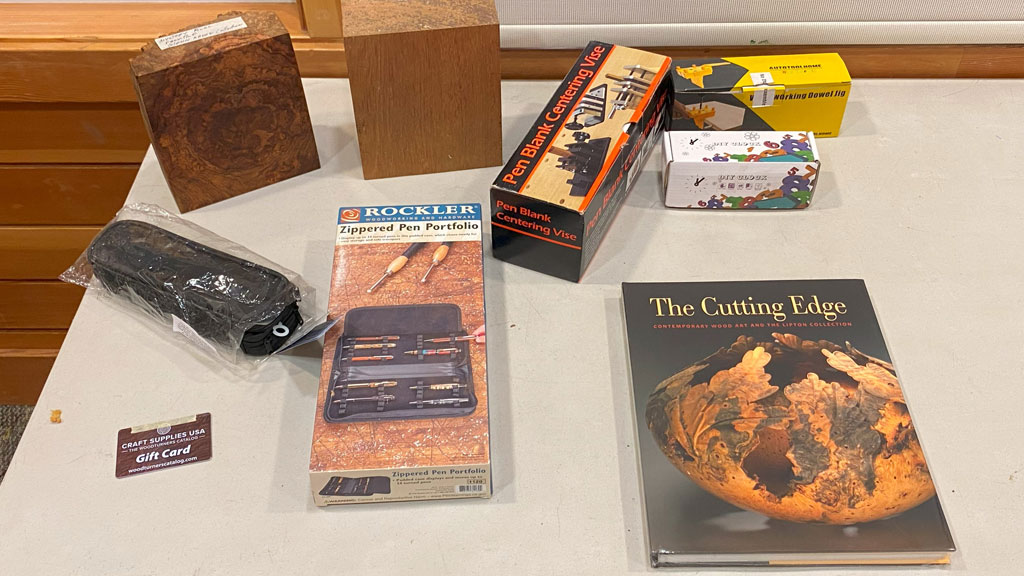
“As the Wood Turns” by David Vannier
I had a couple of ideas of things I could talk about and safety won! At our last meeting, Tom asked 3 questions. 1) Who has had wood come off the lathe? 2) Who has been hit by that wood? & 3) Who has changed the way they turn because of it? I was surprised by how many people raised their hands.
My first piece that came off the lathe, note I said first, weighted about 90 lbs. I was into those wild pieces with all the voids, and still thought it was safe. After all, AAW shows all these pictures of really cool looking pieces. I’d probably only been turning for about 5years, so still a little timid, but willing to try anything even if I didn’t know how to do it. Well no one told me that voids sometimes mean the wood isn’t solid, and can be subject to coming apart. I generally turn at the highest speed I can without the lathe vibrating. Being on a wood floor, this is generally lower than people who are on cement, or bolted down to the cement floor. So I was turning about 600rpm. Not ridiculous by any means. After a couple of cuts, it exploded. A 40 lb block flew off, bounced across the room and slammed into the door. In the meantime time, I was trying to turn the lathe off while it was bouncing around. It made enough noise that my wife came bolting out to see if I was ok. When she heard me laughing she knew I was ok. But, that was probably the last time I turned a piece with voids for a long time. I have turned pieces I probably shouldn’t have since, I turned a hollow form that I finished, sanded, and put a coat of finish on. When I took it out of the chuck, it was 2 pieces. All that was holding it together was the chuck. Guess I got lucky, but what a waste of time.
I had a piece break apart last year, while I was turning it. This one was more dangerous. I was turning thin, and had the speed up a little too high for a thin NE piece. Some of the pieces flew off slamming into my face shield respirator. It blew it apart, shook me up. Everything went back together, so no harm done. But it did enforce why I don’t like face shields. They really should be call chip deflectors, not face shields. They give a false sense of security, and I violated one of my rules: NEVER stand in the line of fire! If you do, sooner or later you are going to eat a piece. If you are lucky, like I was, it will be a piece without the mass to cause a serious injury. If not, well I’ll point to the 3 serious accidents that happened in 2011, 2 deaths and 1 losing part of her face and sight. All were wearing one of the popular recommended face shields. Few of the so called shields will stand up to any serious force. I looked into a hockey helmet with a face shield, but my lungs insisted on a powered respirator. I certainly don’t recommend you not wear a face shield. Just understand its limitations. Regardless of your choices, don’t stand in the line of fire. No face shield or any safety glasses can eliminate all risk.
At Glenn’s sale, Jon and I were talking about grinder safety. One thing we seldom talk about is the dust from grinding. Stone wheels put stone and metal dust into the air. CBN wheels put metal dust into the air. I know some people put a magnet under the wheel to try to capture the dust. I’m not sure how well it does, but we all know that metal or stone dust in the lungs is probably not a good idea. So, make sure you mask up! Craft Supply recently posted a video on grinder safety. I put a link to it on Slack. Warning, it is graphic, but demonstrates how quickly and easily you can get hurt.
Be safe. Think before you do anything in the shop. See you at the next meeting.
Woodturners Newsletter Editing Notes
WBW members, if you have a personal website and would like it included in the President’s Challenge and Show & Tell sections of our Woodturning Newsletter, please let the newsletter editors know. Email us at info@westbaywoodturners.com.
WBW board members and committee chairs
President: Claude Godcharles
Vice President: Tom Gaston
Treasurer: Jon Bishop
Secretary: Laura Rhodes
Member at Large: Dean Caudle
Meeting Program Coordinator: Claude G acting
Visiting artist Coordinator: Dean Caudle acting
Anchor seal: Dennis Lillis
Craft Supply: Tina
Librarian: Kelly Smith
Audio Visual: Curtis Vose, Edgar Whipple
Website: Roman Chernikov
Woodturners Newsletter: Angela, Claude, David, Laura, and Roman

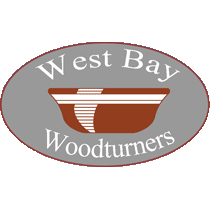

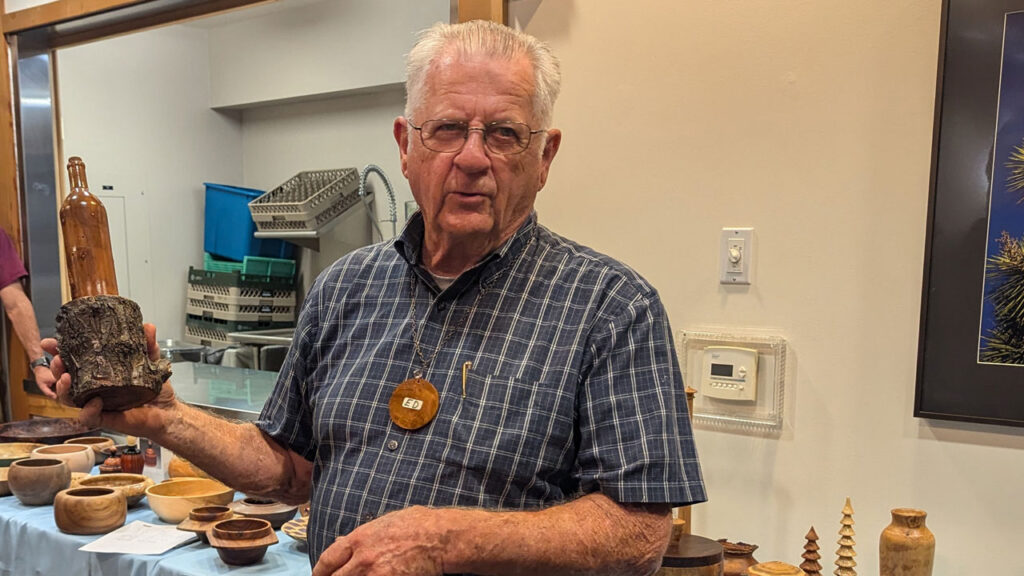
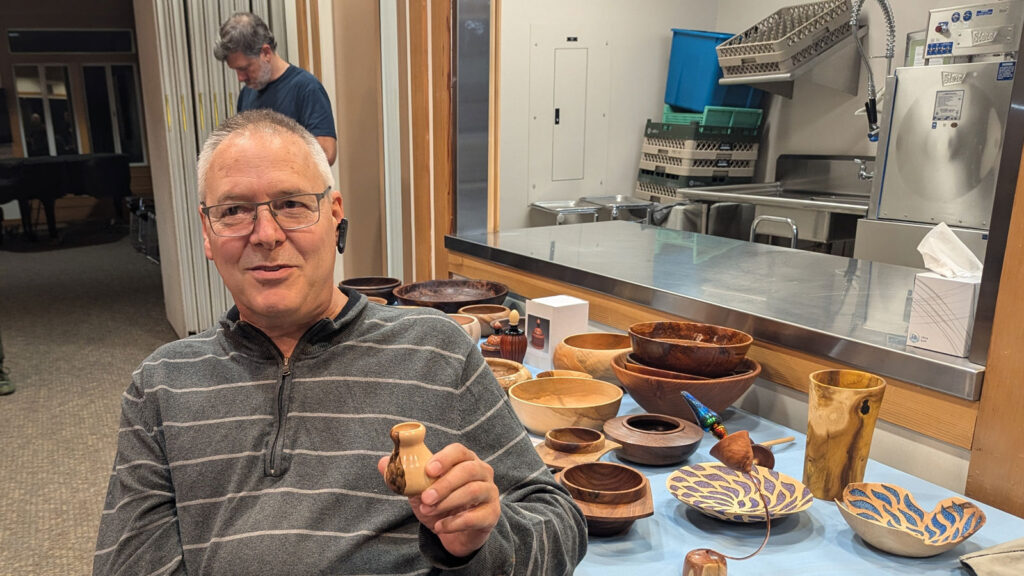

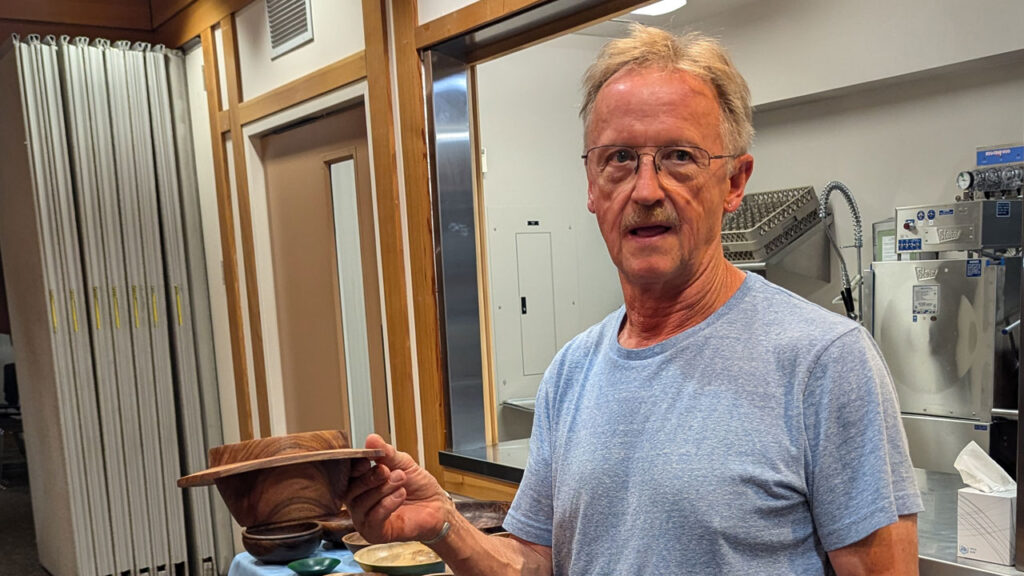
Leave a Reply